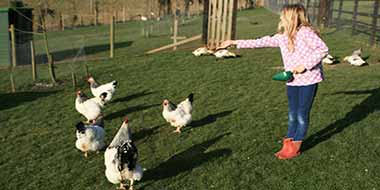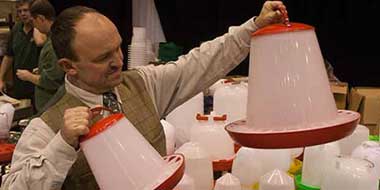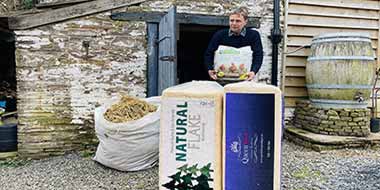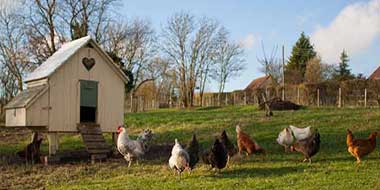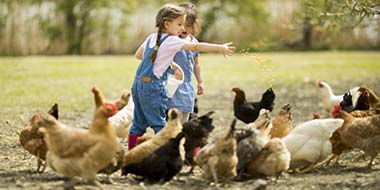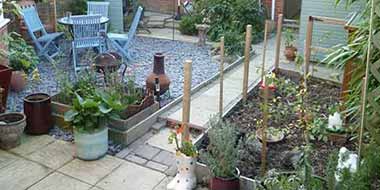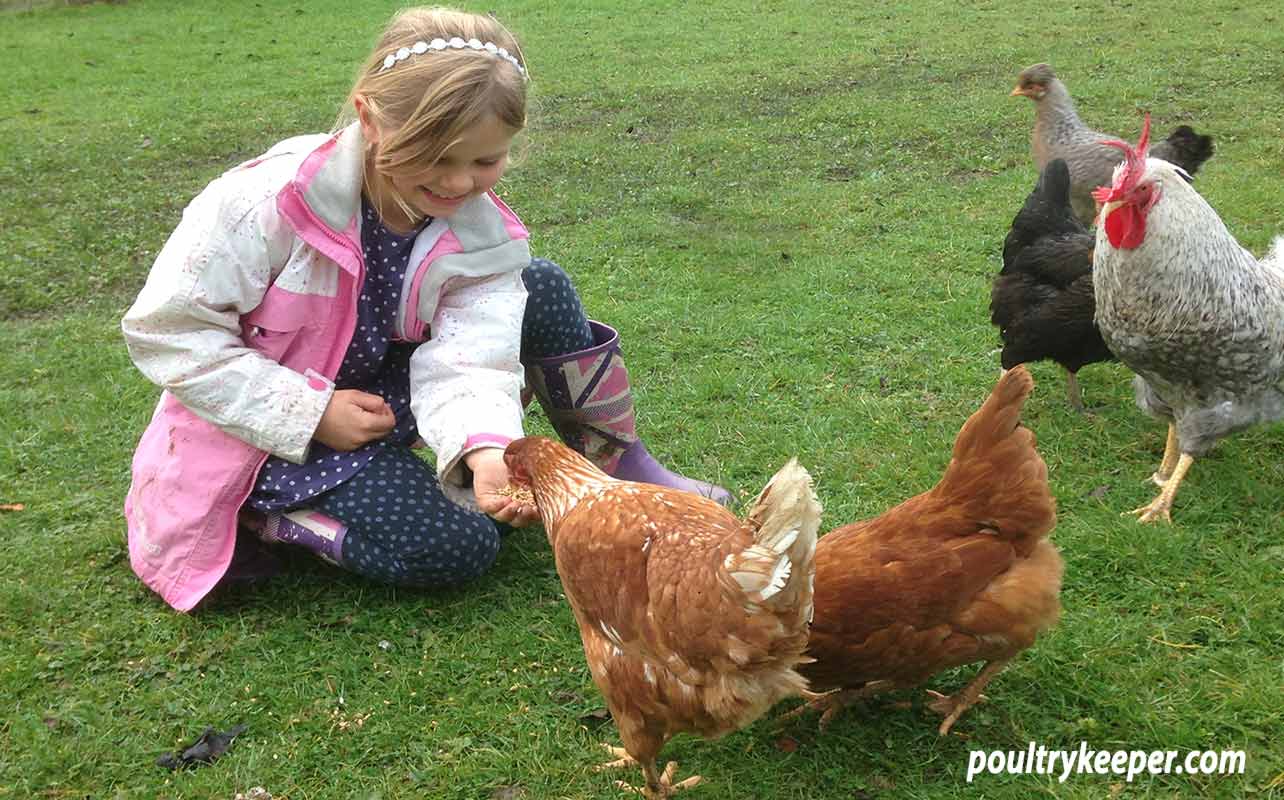
THE
Beginner's Guide
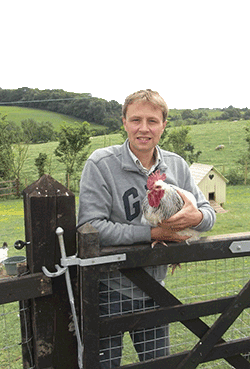
Over the years, I had many local people knock on my door or come up to me to ask whether I was ‘the chicken man’…
After explaining that yes, I kept quite a few chickens, they would say that they were also thinking about getting a few hens at home and had some questions for me… so eventually, I produced a few typed sheets to give to people, and this was how my beginner’s guide to keeping chickens was started before poultrykeeper!
Chickens are easy enough to keep, make productive pets, and most will usually provide you with a constant supply of fresh eggs so it’s no wonder keeping a few chickens in the back garden has become so popular in recent years. As with buying any new pet, the newcomer often has several questions to ask beforehand. This guide aims to cover the basics of chicken keeping to help you decide if chickens are for you, and if they are, it points you in the right direction to get started with your first backyard flock.
To Begin at the Beginning!
I don’t wish to put you off in any way but remember, if you live in the UK, you have a legal obligation under the Animal Welfare Act 2006 which states that …
...you commit an offence if you don't take steps as are reasonable in all the circumstances to ensure the needs of an animal for which you are responsible are met to the extent required by good practice.
The Animal Welfare Act 2006
So, before you start, you need to be aware that chickens need some care and attention every day, just like a dog or a cat would. Before buying some hens for the first time, you should give some thought to the fundamental commitments you will need to make to prevent any welfare issues:
Do you have the time?
As a minimum you need to visit chickens twice per day, usually once in the morning to open their coop, check their wellbeing and top up food and water, and again at night to close their coop so they are secure from night-time predators. The chicken coop will need weekly or bi-weekly cleaning.
Who will look after your chickens if you go away?
You cannot leave chickens when you are away from home overnight. It would be best if you had a plan for looking after your chickens whilst you are away.
Can you provide them with secure housing?
The chicken coop and run needs to be secure, not only to keep your chickens in but also to keep predators out. The main predator for chickens in the UK is the fox and the raccoon in the US, both are generally night-time predators. There are high numbers of urban foxes in our towns these days.
Is your garden/backyard secure?
If you intend to let your chickens free-range, is your garden or back yard secure? As well as keeping them safe from a stray dog or fox that's passing through during the day, you are not allowed to let chickens roam off your property. Neighbours do not appreciate chickens scratching up their flower beds and leaving droppings on their garden path!
Are there any rules preventing me from keeping chickens?
In the UK there are sometimes house deeds or covenants on rented accommodation but in general, there are very few restrictions on keeping hens. If you have any doubts, Laws on Keeping Chickens covers this topic in more detail.
In the US, you must first ensure that your county’s zoning allows chickens to be kept. Restrictions between municipalities also vary considerably and may have further restrictions or requirements for a permit.
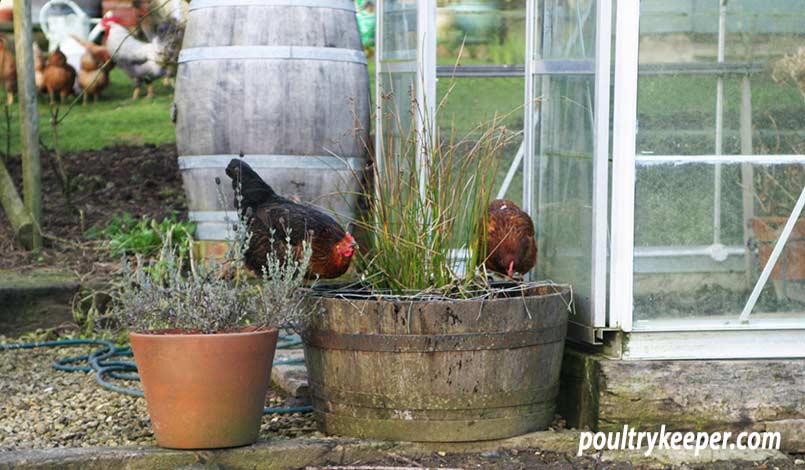
These questions are the essential first considerations to ensure you can meet the regulations and particularly the welfare needs of your hens. These often get overlooked by glossy articles about keeping chickens!
In summary, chickens are relatively low maintenance but you will still need to provide them with the right environment to live in and find enough time in your daily routine for them to keep them happy and healthy.
Chickens can live as long as 15 years or more (although 5-8 years is more common) so it’s a reasonably big commitment. Of course, you can rehome chickens, but keep in mind that older hens are more difficult to sell because the quantity and quality of eggs they lay decreases with age.
Assuming you have the time and commitment, there are many ways to keep hens securely, happy and healthy, even if you have the smallest of back gardens.
So you would like to keep chickens in the back garden? Read on and we’ll dive into the details!
The chicken house
A chicken coop is probably the most expensive thing you will buy, and there are many different designs on the market, some I would buy and many I wouldn’t, so let’s start by looking at what your chickens actually need from their chicken house.
Backyard chickens need suitable shelter to protect them from the elements and to provide security from predators. A big part of this protection comes from their house.
Chickens can withstand freezing temperatures, and like wild birds, will trap air between their feathers to insulate themselves from the cold. Most breeds are hardy and don’t have any problems getting through the UK winters, providing they have adequate shelter from wind and rain.
A chicken house can provide your chickens with the shelter they need during bad weather; however, I find they will often prefer to be outside during the daytime, (even in the worst weather) if there is another shelter option available!
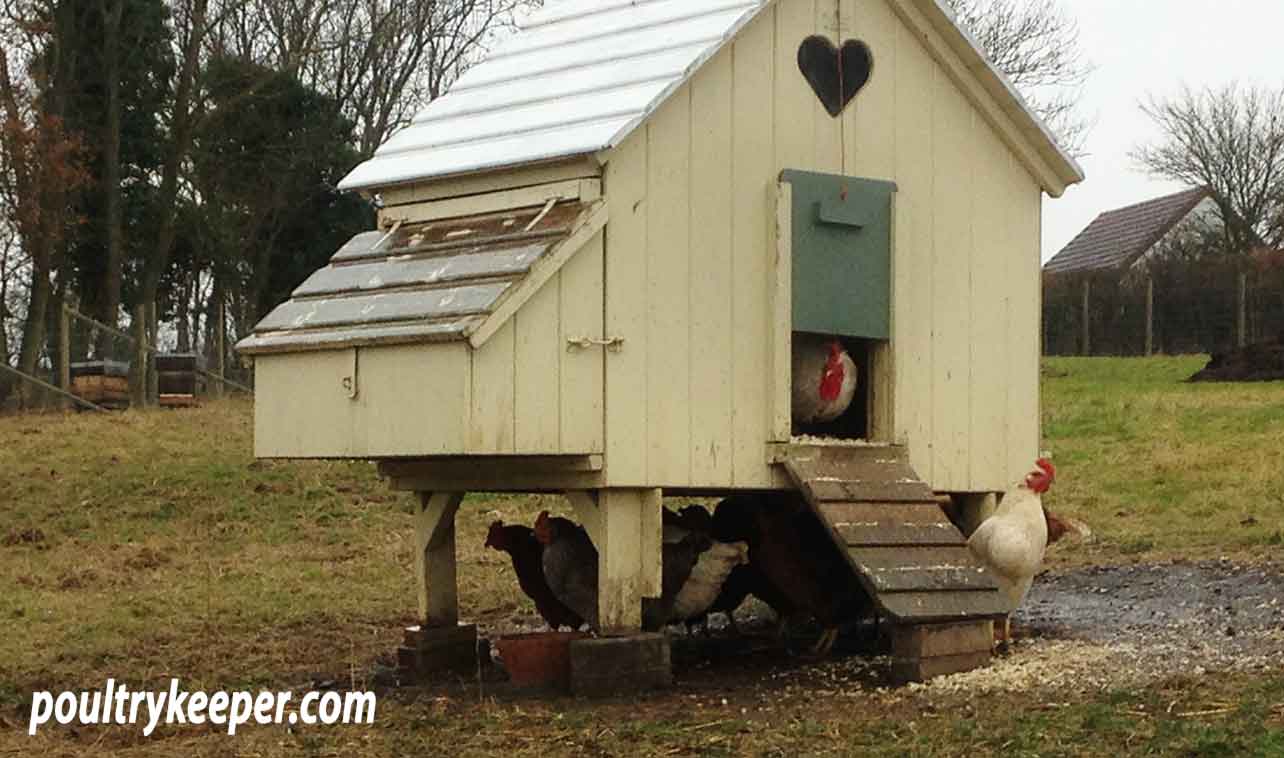
I have always raised my chicken houses off the ground wherever possible. My hens often prefer to take shelter underneath, rather than go into their house.
During Cold Weather
Hens will spend longer inside during the longer nights. Provide a thick layer of bedding to insulate the floor and keep bedding fresh and dry. Ensure vents are facing away from prevailing winds that can cause drafts.
At the opposite end of the spectrum is heat. Chickens cannot cope with high temperatures very well. They can cope with cold temperatures better, so it is essential to help them keep cool on hot days.
Like dogs, chickens cannot sweat. They will pant and drink additional water (which causes them to pass wet droppings, it’s nothing to worry about, they are simply losing heat).
You may also see chickens lying down with their wings spread away from their body. It’s easy to think a chicken has died when they are spread out like this, but they will hop onto their feet if you go over to them.
Raising the chicken house off the ground is again helpful because it can also provide an area of shade for your hens.
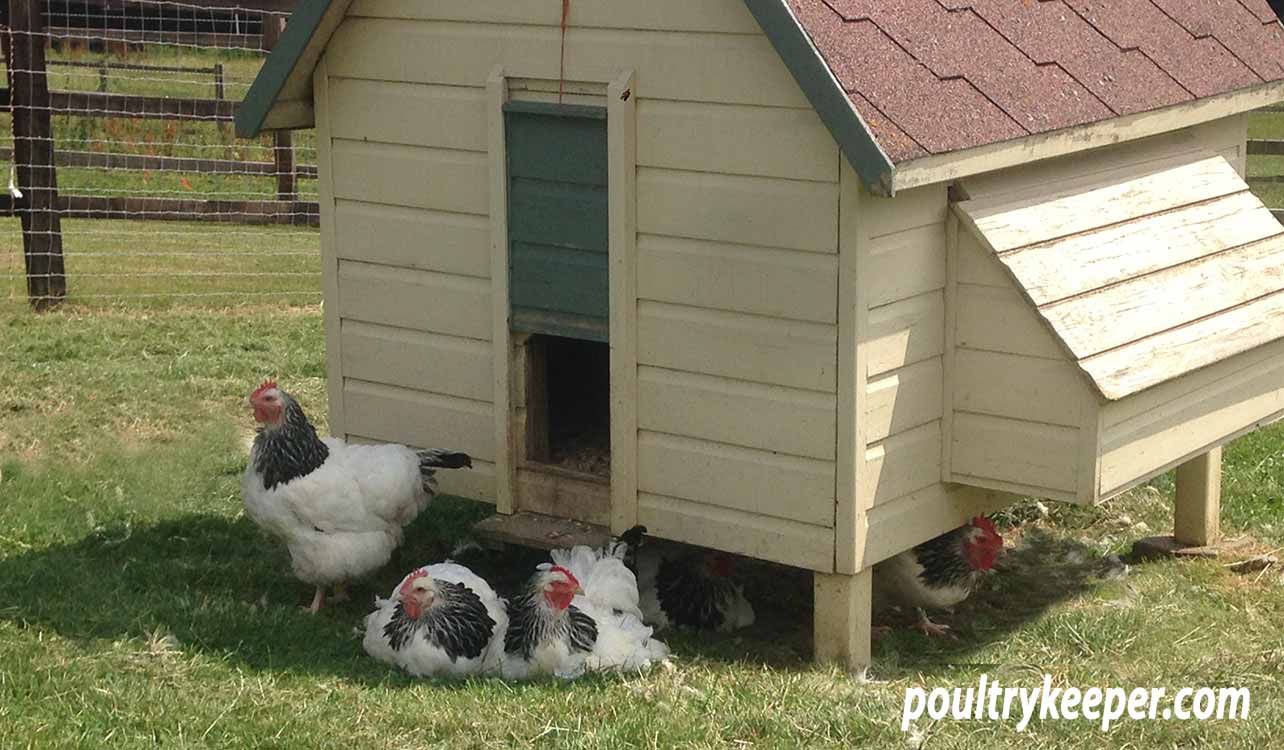
Vents remove stale air and ammonia.
Although the chicken house your purchase or build must shelter your hens from lousy weather and drafts, it must also have adequate ventilation. Chicken droppings are a mixture of solids and urates and give off ammonia. A build-up can harm their respiratory system.
A high-level vent allows warm, rising air and ammonia to escape. An adjustable side vent on the coop is helpful because you can regulate air circulation in different weather conditions.
Finding the right chicken house
When it comes to choosing the right chicken house, there is a choice of wood or plastic, and in the case of wood, build it yourself or buy one.
It is usually a case of ‘you get what you pay for’ with wood. Still, I have been able to keep some cheap chicken houses going for 6 to 7 years with a regular coat of wood preserver and routine maintenance (replacing latches that rusted and roofing felt). For example, I made a cheap chicken house from a wooden packing crate.
When buying a wooden chicken house, take a close look at the thickness/quality of the wood used on a coop. The better quality the wood, the longer it will last, but the more the wood will cost in the first place – horses for courses!
Chicken houses can be beautiful or very basic. For example, you could build your chicken coop out of recycled pallet wood; it does not matter providing it does the intended job, which should be to provide dry, draft-free (but well ventilated) accommodation.
My first DIY coop had several flaws. The pop-hole was too small and the glass window wasn’t ideal, I learned from my mistakes!
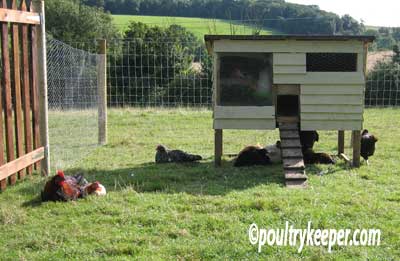
Wood should ideally be pressure treated so that it doesn’t rot in the first year, and nails, screws and fittings should all be galvanised to stop them rusting.
Preserving your coop
When I buy a chicken coop, the first thing I do is paint or preserve it to give it the best possible chance of a long life. If you treat a coop, remember to check that the product is animal friendly and leave it to dry out completely before allowing your birds into it. If you are unsure, give the customer service number a call (usually found on the back of the tin) and ask them for advice.
Essential features
Essential features of the house are nest boxes, ventilation (ideally adjustable) and perches for the birds to roost, but you should also consider how easy it is to collect eggs and how easy it is to clean.
Spending a bit more now to get a house with a droppings board and a large access door will save you hours of struggling in the long run.
If you need more information on housing your chickens, then our Ultimate Guide to Chicken Houses has a lot more details.
My Favourite Chicken Houses
I have several different coops and of course I have some favourites. These days I also consider the environmental impact of my purchases. If you are looking for a house then these are some of my favourite suppliers and what I know about their environmental credentials.
1. Wooden Coops:
- Foresham Cottage Arks - (now Omlet). Traditional, well-built wooden coops from the UK. The Lenham is one of my favourites.
- Flyte So Fancy - Offer some gorgeous coops that are made to a very high standard. They are built with a heart in the heart of Dorset!
- Amazon Chicken House Page - Yes, Amazon have everything. I like the fast delivery and no-hassle returns if something isn't quite right. They have a good range of cheap chicken houses, as well as a few other higher quality models on their market place but do keep in mind the environmental cost of cheap coops which are built and imported from China and won't last as long as a higher quality coop.
2. Plastic Coops:
- Green Frog Designs - are made in the UK from eco-friendly, durable recycled plastic. What's more, they have a 25 year warranty and you can buy them through Amazon, so as well as easy returns if you're not happy, there is fast delivery!
- Omlet - easy to clean and hold their value well. They are colourful and great in both modern or cottage gardens. The down-side is they are not made from recycled plastic and made in China, so are not so good for the environment. They do last a long time though.
Bedding materials
You can spread dust-extracted wood shavings, straw (if it isn’t too dusty), chopped cardboard, easichick or one of the other available bedding materials.
I wrote a separate article on the best bedding material for chickens here.
So how do you get rid of all that dirty bedding material?
You can easily make nitrogen-rich compost from chicken manure and bedding materials. Straw and cardboard compost far faster and gets onto my vegetable patch quicker!
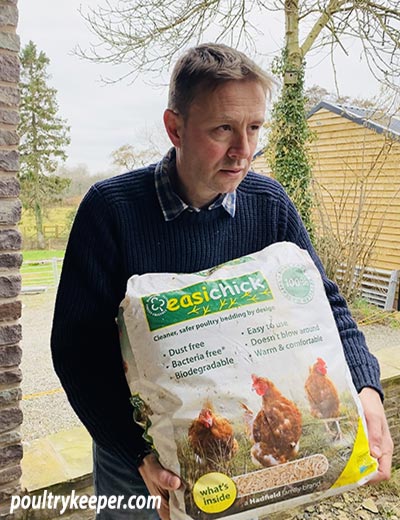
Further reading about chicken houses:
- The Ultimate Guide to Chicken Houses - An in depth look at the features and chicken houses available to house your girls.
- A Complete Guide to Chicken Nestboxes - Whether you decide buy one or build your own or just want to know how many nestboxes your coop should have.
- ChickenGuard Automatic Door - Locking up your birds at dusk is a high priority to avoid a visit from Mr Fox. The ChickenGuard has got you covered!
The chicken run
To keep healthy, chickens need to get fresh air and sunshine.
Like there are many chicken house designs to choose from, many different chicken runs are also available. You can divide the run into two different kinds:
- A small covered run that you attach to the coop. Mostly, these come from the same supplier as your chicken coop, so look to see if you can buy it with your coop.
- A fenced-off area. Which provides them with more space to roam. An overgrown area at the bottom of the garden is ideal!
A chicken run could be the whole of your back garden, or likewise a tiny fenced area or pen. Whatever you decide upon, it is always advisable to have the largest area you can manage so your hens can get as much free-range as possible and security from poultry predators.
If you buy a small covered run, check that it is suitable to keep your chickens in if there is a bird flu lockdown. This means wild birds cannot enter through any holes, and it is covered or can be covered. A tarp over the top of a wire run will often do.
You might need to keep your hens in a small run to keep them safe from predators, but I would encourage you to let them out when you’re at home or in the garden for some time to forage.
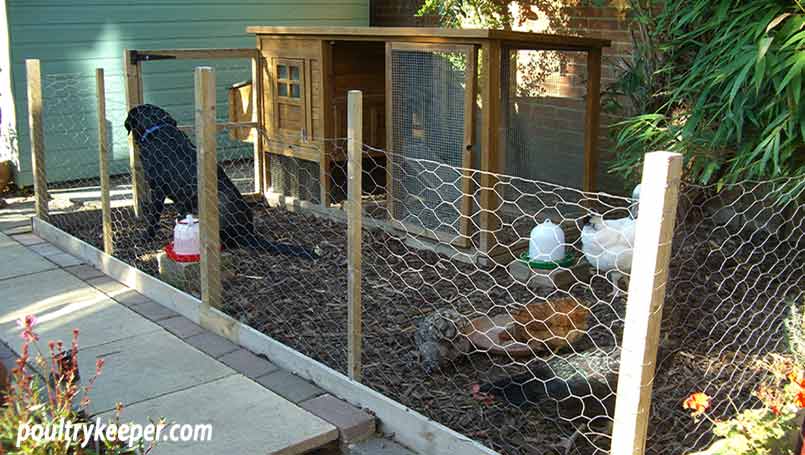
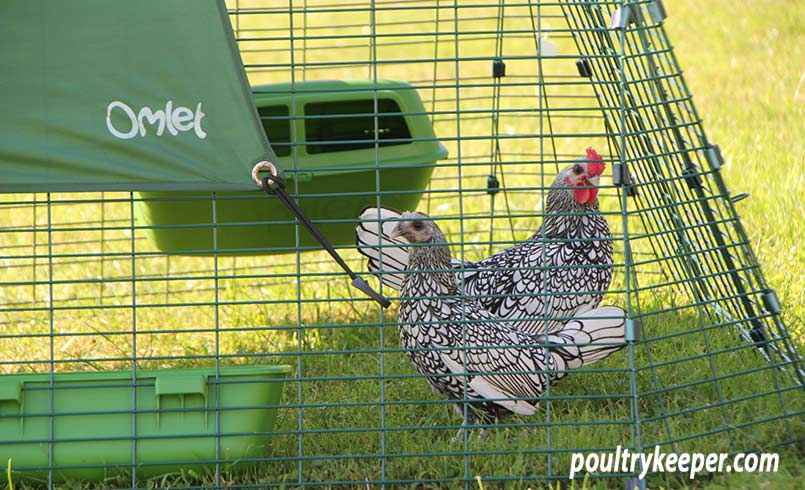
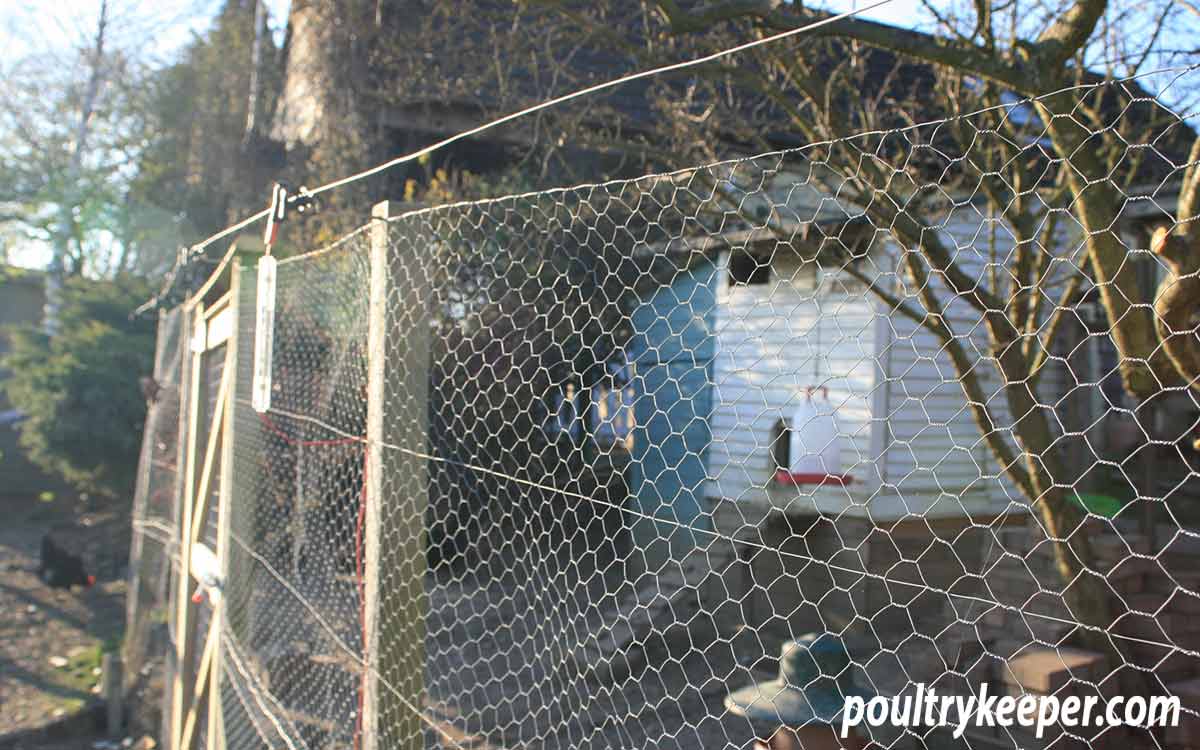
Mud (glorious?) mud.
Unlike Hippos, chickens do not enjoy wallowing in mud. Small runs soon become muddy and smelly during wet weather, and your chickens will quickly become miserable. Poultry worms also thrive, so it’s not a healthy environment for them.
The answer for a small to medium-sized chicken run is to build a base and fill it with a substrate material that can be replaced or washed through easily.
Hardwood chips are a favourite and last for a long time when kept dry. Sand is also popular. Scattering some mixed corn into this daily will give them plenty of opportunities to forage.
Do not use bark chippings. Although these are cheaper, they can go mouldy and cause a respiratory disease called Aspergillosis.
 Scratching and foraging are two of the most natural chicken behaviours and is vital for their well-being, so I do not like to see chicken runs with wire floors that prevent scratching.
Scratching and foraging are two of the most natural chicken behaviours and is vital for their well-being, so I do not like to see chicken runs with wire floors that prevent scratching.
Hardwood chips are handy for muddy areas, such as gateways, entrances to chicken houses and other “high traffic” areas. They are durable and will last for a long time, and you can always add another layer if the mud starts to come through.
Security from predators
Your chicken run needs to be secure – keeping predators out whilst keeping the chickens in.
The main predator to guard against in the UK is the Fox, and in the US, probably the Racoon. Both of these animals are nocturnal so will do most of their hunting at night.
Foxes can be a problem during the daytime, especially when there are fewer hours of darkness during the summer months and they are feeding young.
If possible, bury wire netting at least 20cm into the ground to stop predators from digging under the fence and cover the roof of the run.
Larger runs can have electric fence wires added on insulators where foxes are a particular problem.
Three ‘strands’ of electric wire, tape or rope can be looped back and forth – the first at low-level stops foxes digging underneath, the second is at fox nose height and, together with the upper one, stops the fox from climbing over.
There is more information here on fencing chicken runs with the different options for small backyard runs.
This article on electric poultry netting discusses the use of electrified plastic poultry netting that can be erected quickly and moved around easily in larger spaces.
Tip: Free-Range Hens
Hens love to free-range but they also need to be safe and stay within the boundaries of your property. If there are foxes around during the daytime, keep your hens in a run or behind an electric fence. You can let them out when you are there, they will return to their house to roost at dusk.
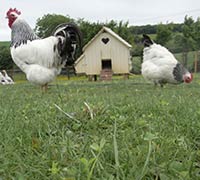
Locking up at night
One of the most important things to keep your chickens safe is to lock them up when it gets dark.
The good news is once your chickens learn where to sleep, they will come home to roost at dusk. This means you could let them out of their run to forage in the garden, and they will come back to their house at bedtime.
If you need them in sooner, shaking and throwing corn in their run is better than trying to herd them. Unlike ducks, chickens do not herd easily; they will go off randomly and not usually where you want them!
It is good to have a friend or neighbour to help you with your chickens if you are going away from home.
One gadget that I absolutely couldn’t be without is my automatic chicken door that locks up the chickens at night and lets them out in the morning, keeping them safe. This means they are safe if I don’t get home in time for dark.
Overhead cover
Trees or shrubs can also protect chickens from bad weather and offer dappled shade during the summer, so they are helpful in larger chicken enclosures.
Chickens are a prey species and will be wary of anything flying overhead, especially in wide-open spaces. Our domesticated chickens are descendants of the Jungle Fowl who live in small groups with plenty of ground and tree cover to hide.
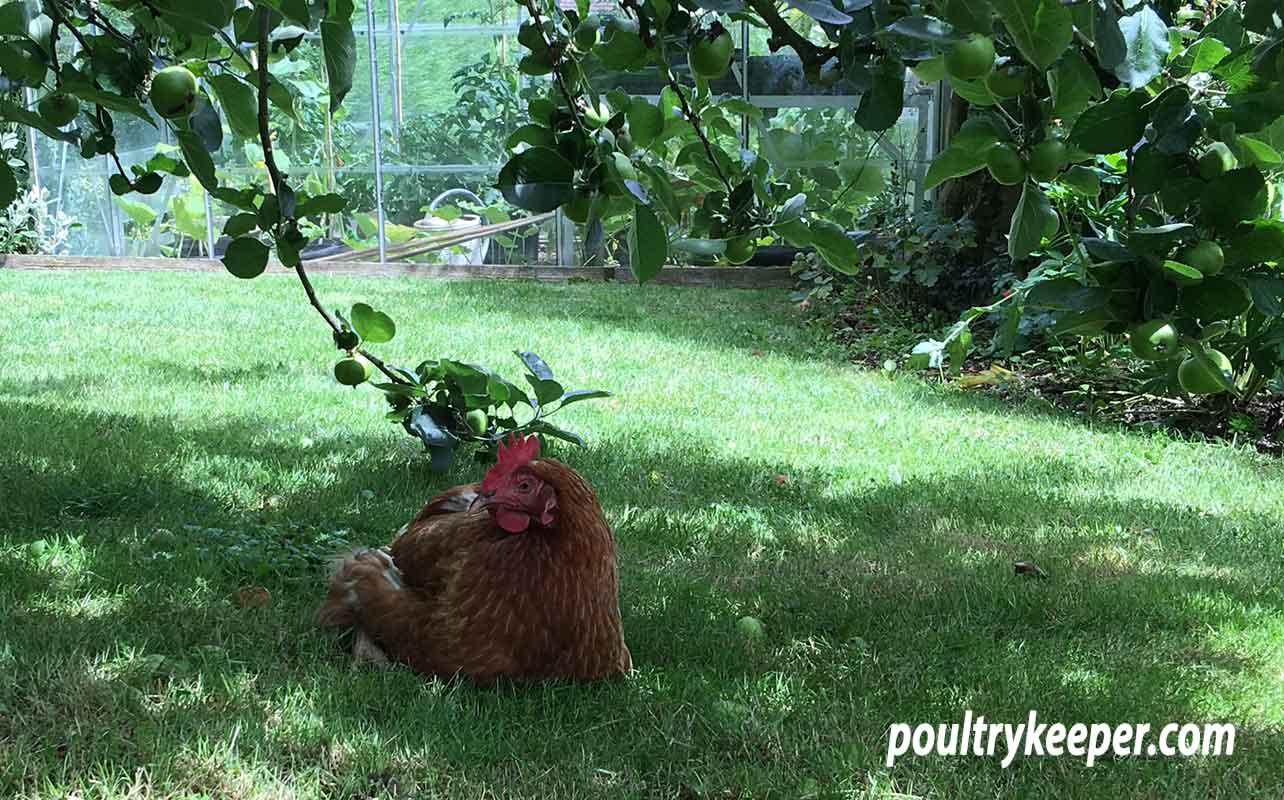
Further reading about chicken runs:
- How much space do chickens need? - It's surprising how you can fit chickens into even the smallest gardens!
- The predators section has further information about several pests and predators. In the UK, the main predator is the fox, and in the US, the Racoon. Both of these will generally hunt at night so locking up your birds at dusk is a high priority!
- List of Poisonous Plants for Chickens - A list of typical garden and hedgerow plants and foods that are poisonous to chickens.
- Chickens and Holidays - Lots of ideas for what to do with your chickens when you go on holiday.
Feeding your chickens
All chickens and poultry need the correct nutrition to grow, remain healthy and lay a good supply of eggs. In days gone by, many people fed their chickens on the household scraps and let them forage for the rest of their diet. This was before formulated rations were available and usually resulted in them not getting the correct balance of nutrients. Modern hybrids, in particular, have much higher nutrient requirements to be able to produce the vast number of eggs they do.
Let me explain how it works.
Chickens will eat to fulfil their energy requirements (and eat more during colder weather to keep themselves warm), so if there is a choice between their layers pellets or some tasty scraps, they will fill up on the scraps first which don’t provide sufficient nutrients. For example, scraps will not usually contain adequate protein. Eggs and feathers require a lot of protein, so if their diet lacks protein, can you guess what they cut back on first?
You guessed it, eggs!
Chickens fed on scraps may, at first glance, look healthy enough, but if there is insufficient protein, minerals, vitamins and calcium in their diet, they will never do as well as they should and never lay as well as they could, given a proper diet.
Layers pellets
Fortunately, some feeds have been formulated to contain the correct balance of nutrients, vitamins, and minerals. If you want healthy birds and a good quantity of eggs, it is advisable to feed one of these formulated feeds.
I provide layers pellets in a hopper and keep treats to no more than 10% of their diet to ensure they receive adequate nutrition.
6KG FEEDER
WITH RAIN HAT
Here is my favourite feeder. It holds 6KG which is large enough for most backyard flocks.
If you have a large flock, it is better to have more than one small feeder, instead of one large one, so hens at the bottom of the pecking order can feed without getting bullied.
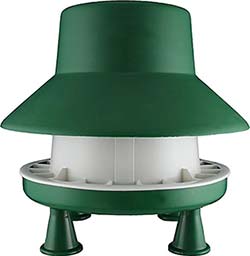
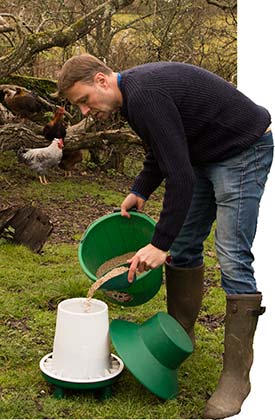
Mixed corn
Mixed corn contains mainly wheat and cracked maize. Wheat is low in protein, and maize is high in energy (valuable as a winter warmer before bed). A common mistake is feeding mixed corn ad-lib in a hopper. It should be kept as a treat. As a rule of thumb, no more than a handful per bird per day.
Kitchen scraps
Since the BSE outbreak, the feeding of household scraps in the UK and Europe is technically illegal, but you can still provide your hens with greens from the garden or allotment (providing you don’t take them into the kitchen first).
Common plants/foods that are poisons for chickens are avocados, potato plant leaves and rhubarb.
Grit
Of course, chickens don’t have teeth, so they need flint grit to grind their food down in a hard, muscular organ called a gizzard. Birds that can roam might find the necessary grit they need, however, there is no guarantee there is sufficient birds are housed in yards or semi-intensively, it is important to include a separate container of mixed grit in order that they can digest their food. Mixed poultry grit is readily available online or from all agricultural suppliers, but you need to make sure that it contains a high proportion of hard flint grit; pure oyster-shell is too smooth when given on its own and could cause compaction in the digestive system.
Water.
Let’s not forget water! Fresh water is essential for chickens, especially during warmer weather. If you remember, chickens cannot sweat; they pant and drink additional water to cool down.
 Several different water containers are available, suitable for young chicks to a large flock of hens. Water containers (also called drinkers) need to keep the water clean and free of droppings. They shouldn’t tip over easily and should be easy for you to clean out daily or at least every other day.
Several different water containers are available, suitable for young chicks to a large flock of hens. Water containers (also called drinkers) need to keep the water clean and free of droppings. They shouldn’t tip over easily and should be easy for you to clean out daily or at least every other day.
Some have legs to lift them off the floor. You will need to place containers on a level surface. A levelled paving slab can be helpful for this. Many have a handle, and using a sturdy hanging basket chain with a hook at the end, you can hang them up, which is useful when there isn’t a level surface.
Drinkers should store enough water to last all day with some spare capacity for hot days, and as a general rule of thumb, I allow a litre capacity per chicken plus a litre spare.
They should always have fresh water available, so it’s essential to have enough drinkers available for the birds at the bottom of the pecking order to get to one without being bullied. This may mean providing at least two water containers at different ends of the chicken run for some flocks.
Click here to see a range of plastic water containers on Amazon.
During Hot Weather
Fresh water and shade should always be available. Chickens drink more during hot weather to cool down, so it is important to keep water containers as cool as possible by placing them in the shade.
Apple cider vinegar
Apple cider vinegar is beneficial for chickens. It is acidic, so cannot be provided in galvanized water containers without them corroding. Plastic containers are the most popular and the least expensive. Another advantage of plastic drinkers is that you can see how much water is left, but be careful during cold weather because they can split if you knock them when the water is frozen.
I wrote a separate article about the benefits of apple cider vinegar for chickens which I have been using for several years.
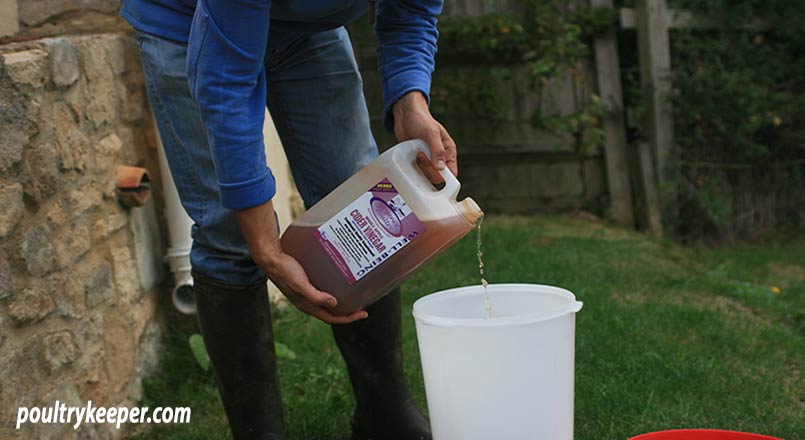
Choosing your chickens
Now comes the hardest part- selecting the type of chickens you want to keep!
Hybrid chickens are generally better for beginners. They are usually vaccinated, lay better than pure breeds, are friendly and aren’t too flighty.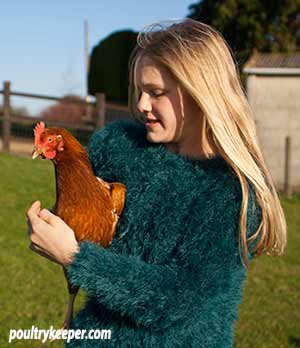
If you can’t make your mind up, then Anne wrote an excellent article: What are the Best Laying Hens, Hybrids or Pure Breeds? which I’m sure will help you to decide.
If you are thinking of getting some pure breed chickens, then look through our Chicken Breeds section but keep in mind you may have to travel and book some rare breeds in advance.
Try to think about what you want your chickens for. Do eggs take priority? Do you want a rare breed? Will you want to breed from your hens? You don’t need a cockerel for chickens to lay eggs, and male birds can make a lot of noise, too, disturbing neighbours as well as you in the early hours of the morning – so you’ll probably want to start with a few hens first.
Think about what size of birds you can accommodate in the space available – Large fowl or bantams. Unless you have a fairly large set-up, it is advisable not to mix different sized birds to have fewer problems with bullying.
It is also best to buy all of your chickens in one go from one breeder where they have been kept together if you can; this ensures they all get along well, and they will settle in faster. Introducing new birds is rarely pleasant as they re-establish the pecking order.
Most of all – have fun choosing your hens; I think you will find them incredibly rewarding and I bet you’ll start with a few and then want some more!
Chicken Breeds Pages
If you are interested in keeping pure breeds, the Chicken Breeds page has photographs of all 93 standardised chicken breeds plus many breed profile pages with more detailed information about a breed.
Further reading
A FAMILY
GUIDE TO
KEEPING CHICKENS
It includes planning for your first chickens, understanding their behaviour, choosing suitable housing as well as chickens, equipment you will need, and routine care. Protecting against predators, dealing with parasites and ailments, broody hens and much more.
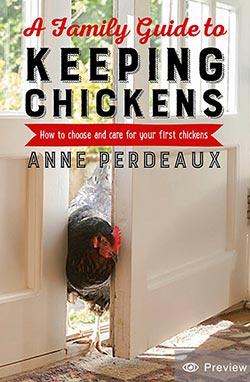
If you liked this guide, I would appreciate you sharing it. We are a hobby website and don’t advertise, so believe it or not, every single share helps us enormously.
Finally, I have included some frequently asked questions below, which may be helpful if you still have some questions!
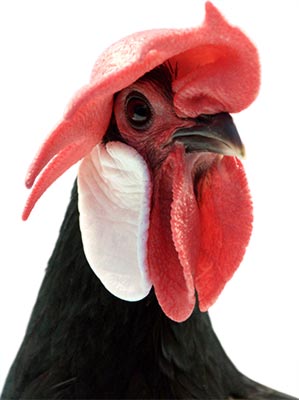
Frequently Asked Questions About Keeping Chickens
Are chickens noisy?
1. Cocks
You probably already know that cocks can be noisy when they crow. They are most prolific in the morning; however, they can start just before daylight which is often an issue in the summer months, especially for light sleepers.
Generally speaking, the bigger the bird, the louder that crow is. The crow from a Pekin bantam or Sebright bantam cock is shrill but probably not too offensive to neighbours if they aren’t too near, and you can keep them in until everyone is awake, but a Marans or Orpington cock can be heard a mile away!
2. Hens
With hens, it can depend. A hen will be quiet most of the time, but if she has laid an egg (or is startled by something), she can start cackling with the typical “buk-buk-buk-bukker” sound. It won’t usually last for longer than five minutes.
If I keep chickens will I get rats?
A common belief is that you will get rats if you keep chickens, but chickens do not attract rats. It is usually the easy access to chicken food that attracts rats.
Rats will look for shelter, food and water, which is available in most chicken runs.
Rat-proof feeders are a worthwhile investment, and there are other preventative measures you can take.
You can learn how to prevent or get rid of rats in this guide.
How many eggs do chickens lay?
Hybrid layers have been bred to lay the most eggs for the minimum amount of feed. The little brown hens called Warrens or Goldlines are usually the best and are found in commercial egg production units and can lay over 320 eggs per year, however, the nutritional demands on these hens are high and they tend to live shorter lives than others.
Most other hybrid layers will lay over 200 eggs per year and some pure breeds that have been selected for egg production will lay similar amounts.
Most high-producing hens in peak condition will lay almost an egg per day during the spring. They will usually stop laying when they moult in the autumn and over the darker days of December and early January.
What do you call a male chicken? A rooster, cockerel, or cock?
In American English, a male chicken is called a rooster.
In British English, a male chicken up to one-year-old is called a cockerel. After this, he is called a cock.
What does Point of Lay Mean?
As the name suggests chickens are about ready to lay their first eggs. This is usually at 18 to 20 weeks old. Pure breeds can take longer and heavy breeds can take up to 30 weeks.
Do you need to worm chickens?
The advice used to be to worm chickens routinely and most backyard flocks were wormed twice per year: in the spring and again in the autumn using Flubenvet (in the UK).
With concerns of drug resistance and the availability of herbal supplements such as Verm-X (which can help to keep the gut healthy), with postal worm egg count kits, we can now avoid medicating chickens unnecessarily with wormers, by testing for the presence of worms.
I wrote an in-depth guide to worming chickens if you would like to find out more.
How high does a chicken fence need to be to keep chickens in?
The answer to this question depends on the breed of chicken in question.
Generally speaking, a 6-foot fence is suitable to keep chickens in and predators out.
Mediterranean breeds (such as the Leghorn, Minorca, Spanish, Ancona and Andalusian) and other light breeds can fly well, so they may need to have one wing’s feathers clipped to unbalance their flight and keep them in.
What cover should chickens have in their run?
Chickens are prey animals, so they appreciate the security of cover from trees or their housing. They have monocular vision (their eyes are on either side of their head with a separate image for each eye). They will spot anything passing overhead and often tilt their head to assess it. If they feel a threat (such as a bird of prey), they will usually run for cover.


